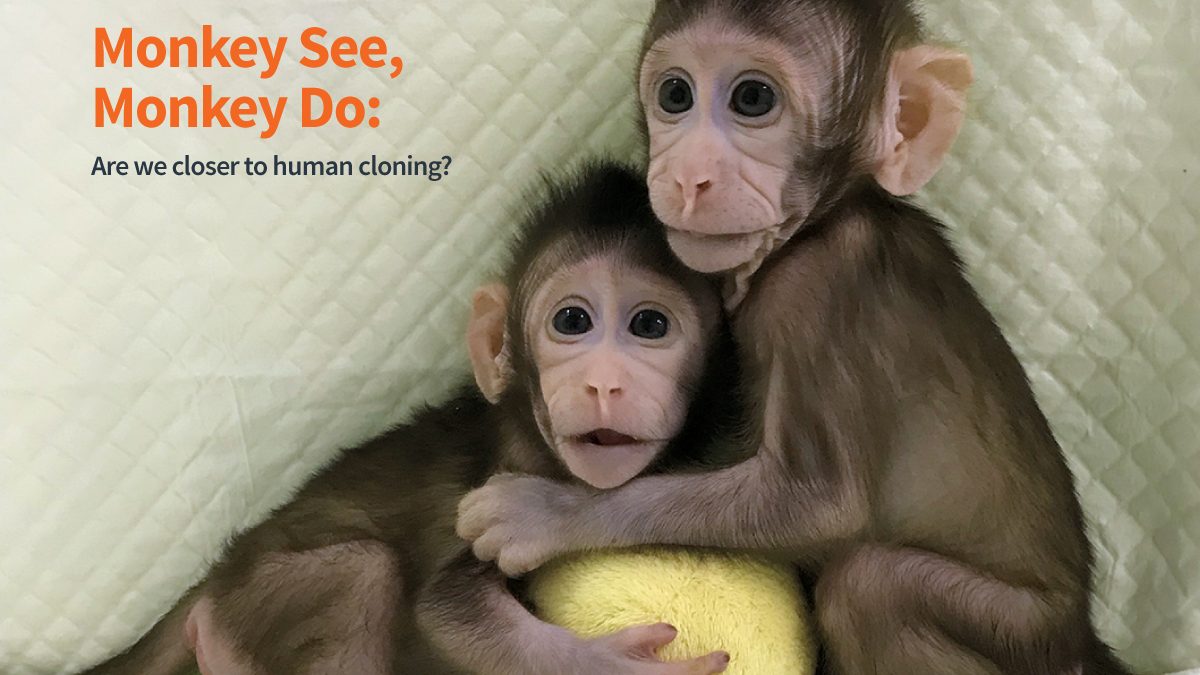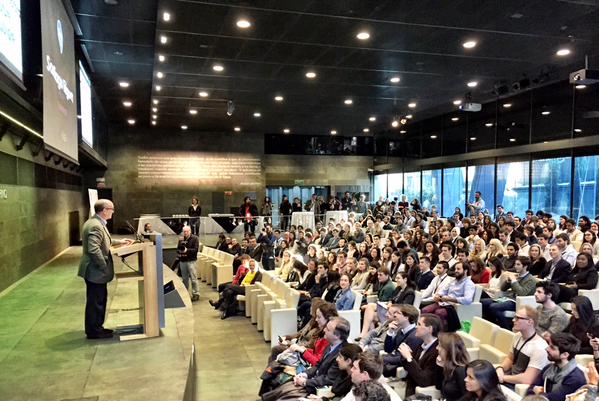- Invest in our thought leaders. Achieve your business goals. TacitKey For Business

Top 3 MedTech trends that Healthcare professionals should look out for!
January 17, 2018
Expert opinions: What is on the horizon for the healthcare industry?
March 23, 2018On January 24th, 2018, the Institute of NeuroScience at the Chinese Academy of Sciences announced that they had successfully cloned two monkeys using reproductive cloning. Reproductive cloning or Somatic Cell Nuclear Transfer (SCNT) is the very same method that had been used to produce Dolly, back in 1996.
Video courtesy: Associated Press
The team under the leadership of Qiang Sun were able to produce two identical long-tailed macaques – Zhong Zhong and Hua Hua. This has been heralded as a ground-breaking achievement, as it has opened the doors to the large-scale production of genetically identical animal models for research purposes.
What is Somatic Cell Nuclear Transfer?
In Somatic Cell Nuclear Transfer (SCNT) technology, the nucleus from a healthy egg is replaced with that from another cell. The resulting embryo is subsequently implanted into a surrogate mother to produce cloned offsprings.
Not the first cloned primates – Then why the hue and cry?
Zhong Zhong and Hua Hua are not the first animals or even the first primates to be cloned. The first animal to be cloned was obviously Dolly, which created a huge uproar globally. The first primate to be cloned was Tetra, a rhesus monkey that was cloned using the embryo splitting method. In 1997, two monkeys were cloned from early embryonic cells using SCNT – Ditto and Neti.
Then why is the cloning of Zhong Zhong and Hua Hua such a big deal?
Zhong Zhong and Hua Hua have been cloned from the connective tissue cells that were obtained from monkey fetuses. In addition, the eggs were also treated with a mix of chemical signals, in order to induce them to develop into embryos.
According to Mu-ming Poo, the Director of the Institute of Neuroscience at the Chinese Academy of Sciences, “The trick is we choose the right chemicals to turn on these genes we transfer into the egg. So that’s what we did differently. I think that’s the key.”
Both these factors set this technique apart. These ensure that these cells can be cultured in laboratory settings – facilitating the mass creation of clones as well as modification of the cells easily in a petri dish.
Reactions from the authors and their outlook on the impact of their work
“We’re excited – extremely excited,” Mu-ming Poo said. “This is really, I think, a breakthrough for biomedicine.”
“We tried several different methods, but only one worked,” Qiang Sun, the Director of the Nonhuman Primate Research Facility at the Chinese Academy of Sciences Institute of Neuroscience said. “There was much failure before we found a way to successfully clone a monkey.”
According to Mu-ming Poo, the approach used in the study “is more customizable and can produce a greater number of genetically identical animals”. He adds that “combining SCNT with gene editing will allow researchers to create ideal nonhuman primate models for studying disease mechanisms and screening drugs. Improving [the methods used] could lead to higher success rates and possibly even the ability to use adult tissues”.
“There are a lot of questions about primate biology that can be studied by having this additional model,” Qiang Sun says. “You can produce cloned monkeys with the same genetic background except for the gene you manipulated. This will generate real models not just for genetically based brain diseases, but also cancer, immune, or metabolic disorders and allow us to test the efficacy of the drugs for these conditions before clinical use.”
Expert opinions on the cloning of monkeys using SCNT
According to Shoukhrat Mitalipov, the Director of the Center for Embryonic Cell and Gene Therapy at the Oregon Health & Science University in Portland, Oregon, “It’s been tried for so many years and it hasn’t worked. This time it worked, which is a big deal.”
“I think it’s a very exciting landmark. It’s a major advance. It should be possible to make models of human disease in those monkeys and study those and then attempt to cure it.” says Dieter Egli, Reproductive Biologist at Columbia University.
However, not everyone is excited about the achievement. Some researchers, even though they appreciate the science involved do not find the approach to be practical or see the need for monkey studies.
According to Pablo Ross, Geneticist at the University of California, Davis, “It’s feasible so that’s a good thing. But I don’t see it being practical.”
“It’s a good piece of science,” says Alan Trounson, Stem Cell Scientist at the Hudson Institute for Medical Research in Clayton, Australia. “[But] I can’t see a high desire to use cloned monkeys for research.”
The potential ethical implications involved
The news of the successful cloning of monkeys has brought the possibility of human cloning and designer babies right to our doorsteps!
“Humans are primates. So (for) the cloning of primate species, including humans, the technical barrier is now broken. The reason we broke this barrier is to produce animal models that are useful for medicine, for human health. There is no intention to apply this method to humans.” Mu-ming Poo said at a conference.
“People may wonder: Are human beings next? People have always been worried about the possibility of human cloning. And this is just yet another step in that direction.” says Insoo Hyun, a Bioethicist at Case Western Reserve University.
According to Dr. George Daley, Dean of the Harvard Medical School, “We live in such a celebrity-driven world that there are unscrupulous practitioners who might try this. Cloning one individual in the image of another real sort of demeans the significance of us as individuals. There’s a certain sort of gut sense that it violates sort of natural norms.”
“To say it’s OK for some scientist or some parent to go ahead for no good reason to produce a cloned child would really demean what it means to be human,” says Marcy Darnovsky, the Executive Director of the Center for Genetics and Society.
Even though some scientists fear that in spite of the strict laws existing in most of the countries against human cloning, someone may attempt human cloning. Mu-ming Poo and the team acknowledge the ethical issues raised by their work, as their technique can be applied to clone humans as well, at least theoretically.
According to Mu-ming Poo, “Technically speaking one can clone human. But we’re not going to do it. There’s absolutely no plan to do anything on humans. [But] I would think society and the general public and governments will not allow extension of this method from nonhuman primates to humans.”
As eloquently put by Peter Andrews, Professor, Department of Biomedical Sciences at the University of Sheffield, UK, “It could be a step towards human cloning, but why would you do it? In terms of human biology, it’s illegal to clone a human in Britain and many other countries, and I don’t think anyone would rationally want to do it.”
Furthermore, ethicists are also concerned about the monkeys themselves. “At present, it has not been sufficiently demonstrated that there are no alternatives to using macaque monkeys for such research,” says Peter Dabrock, Chair, Department of Theology at Friedrich-Alexander University in Erlangen, Germany.
“It gives this sense that animals are disposable and commodities for us to use. Is this appropriate, to have an animal you can do whatever you want to?” says Kathleen Conlee, Vice President of Animal Research Issues at the Humane Society of the United States.
Mu-ming Poo admits that the use of non-human primates for research purposes is more prevalent and acceptable in China. However, he argues that “Once we demonstrate the cloned monkey’s usefulness in curing disease, I hope [Western societies] will gradually change their minds.” Furthermore, he reiterates that his group has been following all the international guidelines for the care of monkey models used for research.
What are the implications of this study to human cloning?
This study implies that human cloning is technically possible in the near future. “The genie’s out of the bottle now,” says Jose Cibelli, a cloning expert at Michigan State University.
Should reproductive cloning proceed? This is entirely another matter. However, all the scientists are of the opinion that human cloning will be irresponsible and completely unnecessary.
Bioethicist Kahn urges a global discussion on this issue: “What should we do about it – the ‘we’ being societies, countries, oversight bodies, governments?” he says. “What kind of governance do we think is necessary to prevent bad things from happening to humans, in the context of technology like this?”
Call for stricter rules and legislations
According to Wang Yue, Professor at the Institute of Medical Humanities, Peking University, “The legislature needs to draft a new law and corresponding regulations on the issue to suit the needs of the times. Technology is neutral, but we need a specific law to prevent vested interests from abusing technology.”
In conclusion, it is important to note that, “Just like nuclear power and artificial intelligence, cloning technology is also a double-edged sword,” as mentioned by Qiang Sun.
What are your opinions on Human Cloning? Should there be stricter laws to dissuade anyone from attempting to clone humans? What is your reaction to the news about the cloning of the monkeys?
These opinions are from thought leaders in the field of Life Science. You could be one of them too. Start your thought leadership journey at TacitKey!





